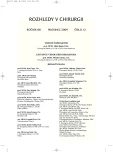Intraoperative Angioplasty and Cross-Over Bypass with Aorto-Bifemoral Bypass in Revascularization of Iliac Arteries
Authors:
M. Beňo; G. Rümenapf
Authors‘ workplace:
Diakonissenstiftungs KKH, Speyer-Mannheim, SRN
Published in:
Rozhl. Chir., 2009, roč. 88, č. 12, s. 720-724.
Category:
Monothematic special - Original
Overview
Objective:
Authors analyze and compare hybrid vascular procedures (HOP) in revascularization of inflow arteries in the form of intraoperative stentangioplasty of iliac arteries combined with ilio/femoro-femoral cross-over bypass with conventional vascular procedures (KOP) in the form of aorto-bifemoral bypass.
Material and Methods:
In all patients, admitted for bilateral revascularization of inflow arteries with hybrid or conventional procedure age, sex, comorbidity, stage according to the Fontain were reviewed prospectively. In all procedures following qualitative und quantitative data were collected: duration of the procedure, technical success (only in hybrid procedures), and peroperative mortality. In postoperative period following data were collected: wound healing problems, need for transfusion, need for observation in the ICU, duration of hospital stay, clinical success, patency and postoperative mortality 0-12 months after the operation. For statistical analysis of collected data statistical software SPSS 16 was used.
Results:
Within the year 2005–2007 (vascular centre Speyer – Mannheim) 20 hybrid procedures (HOP) in the form of intraoperative stentangioplasty of iliac arteries combined with ilio/femoro-femoral bypass were performed. Hybrid procedures were realized in 11 man (61.72 ± 12.61) and 9 women (62.2 ± 8.13). In similar indications was in the same period 14 conventional procedures (KOP) performed in the form of aorto-bifemoral bypass.
Technical and clinical success were in HOP procedures achieved in 19 (95%) cases. Duration of operation was 97.36 ± 19.04 minutes, duration of hospital stay was 8.94 ± 4.01 days. Primary patency was in HOP procedures (0–12 months) observed in 19 (95%) cases. There was no perioperative and postoperative mortality observed during the follow up. A statistical analysis and comparison of hybrid and conventional procedures showed a significantly shorter duration of hybrid procedure (p < 0.001), significantly shorter hospital stay (p = 0.002), reduce wound healing problems (p = 0.022), need for transfusion therapy (p < 0.001) and need for observation in the ICU (p < 0.001) without a significant difference of clinical success and patency (0–12 m).
Conclusions:
Hybrid procedures enormously expanded the possibilities of vascular surgery. In our opinion hybrid procedures in operative therapy of selected patients with symptomatic PAOD enable to reduce the extent of the operation, shorten the operating time, time of hospital stay and better the comfort for high risk patients. Using hybrid procedures especially in revascularization of inflow arteries enables to achieve good short-middle term results with lower complication rates.
Key words:
hybrid vascular procedures – intraoperative angioplasty of iliac arteries – conventional vascular procedures – cross-over bypass
Sources
1. van Dongen, H. G. Gefäßchirurgie, Springer, 1987, 2004, s. 3–829.
2. Šefránek, V., Tomka, J., Záhorec, R., Mazuch, J. Hricák, V. Ochorenia končatinových artérií a ich chirurgická liečba. SAP, 2001, s. 11–236.
3. Beňo M. Hybridné operačné postupy v cievnej chirurgii. Lekársky Obzor, 2007, 56, s. 495–499.
4. Allenberg, J. R., Kallinowski, F., Raithel, D. Endovaskuläre Chirurgie. Heidelberg – Leipzig, 1988, s. 1–127.
5. Schmedt, C. G., Sadeghi-Azandaryani, M., Steckmeier, B. M. Operative und endovasculäre Therapie der aortoiliakalen Strombahn. Gefässchirurgie, 2007, 12, s. 253–268.
6. Wintzer, C., Daum, H., Diener, H., Larena, A., Schrôder, A., Schulenburg, B., Gross-Fengels, A., Imig, H., Debus, E. Kombination von PTA der Spendenarterie und Cross-over-Bypass bei bilateraler Beckenarteriensklerose. Gefässchirurgie, 2006, 11, s. 84–93.
7. Roberts, Schlosser, Wong Interventionelle Radiologie – Die top 100 – Interventionen, Springer, 2003, s. 3–392.
8. Powell, R. J., Fillinger, M., Bettmann, M. The durability of endovascular treatment of multisegment iliac occlusive disease. J. Vasc. Surg., 2000, 31, s. 1178–1184.
9. Bjorses, K., Ivancev, K., Riva, L.,Manjer, J., Uher, P., Resch, T. Kissingstents in the Aortic Bifurcation – a Valid Reconstruction for Aorto-iliac Occlusive Disease. Eur. J. Vasc. Endovasc. Surg., 2008, 36, s. 424–431.
10. Norgren, L., Hiatt, R., Dormandy, A. J., Nehler, M., Harris, A. K., Fowkes, F. G., Rutherford, R. B., TASC II working Group Inter-Society Consensus for the Management of Periphereal Arterial Disease (TASC II). Europ. J. of Vasc. and Endovasc. Surgery, 2007, s. 2–75.
11. Yadav, J. S., Casserly, I. P., Sachar, R. Manual of peripheral vascular Intervention. Lippincott Williams & Wilkins, 2005, s. 1–374.
Labels
Surgery Orthopaedics Trauma surgeryArticle was published in
Perspectives in Surgery

2009 Issue 12
Most read in this issue
- Management of Diaphyseal Forearm Fractures Using LCP Angle- Stable Fixation Devices and Intramedullary Nailing
- Liver Cystadenoma
- Blunt Carotid Injury
- Intraoperative Angioplasty and Cross-Over Bypass with Aorto-Bifemoral Bypass in Revascularization of Iliac Arteries
